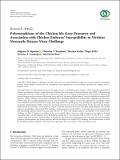| dc.description.abstract | Newcastle disease is a devastating viral disease of chicken in low- and middle-income countries where the backyard production
system is predominant. Marker-assisted selection of chickens that are resistant to Newcastle disease virus (NDV) is the promising
strategy that needs to be explored. )e aim of the present study was to investigate polymorphisms of the promoter region of the
chicken Mx gene and association with Kuroiler, Sasso, and local Tanzanian chicken embryos’ survival variability to virulent NDV
infection. Chicken embryos were initially challenged with a minimum lethal dose of virulent NDV suspension and then were
followed over time to gather information on their survival variability. Using the survival data, high and less susceptible cohorts
were established, and a total of 88 DNA samples from high and less susceptible groups were genotypes by sequencing. Five singlenucleotide
polymorphisms (SNPs), which were previously reported, were detected. Interestingly, for the first time, the findings
demonstrated the association of the promoter region of chicken myxovirus-resistance (Mx) gene polymorphisms with chicken
embryos’ susceptibility to the virulent NDV challenge. At the genotypic level, the SNP4 G>A mutation that was located within the
IFN-stimulating response element was associated (LR: 6.97, P � 0.03) with chicken embryos’ susceptibility to the virulent NDV
challenge. An allele G frequency was higher in the less susceptible cohort, whereas an allele A frequency was higher in the high
susceptible cohort. At the haplotype level, the haplotype group ACGC was associated (OR: 9.8, 95% CI: 1.06–79.43, P � 0.042)
with the same trait and had a resistant effect. In conclusion, the results have demonstrated the association of chicken Mx gene
promoter polymorphisms and chicken embryos’ survival variability to the virulent NDV challenge, and the information is useful
for breeding programs designed to develop chicken genotypes that are resistant to Newcastle disease virus. | en_US |

